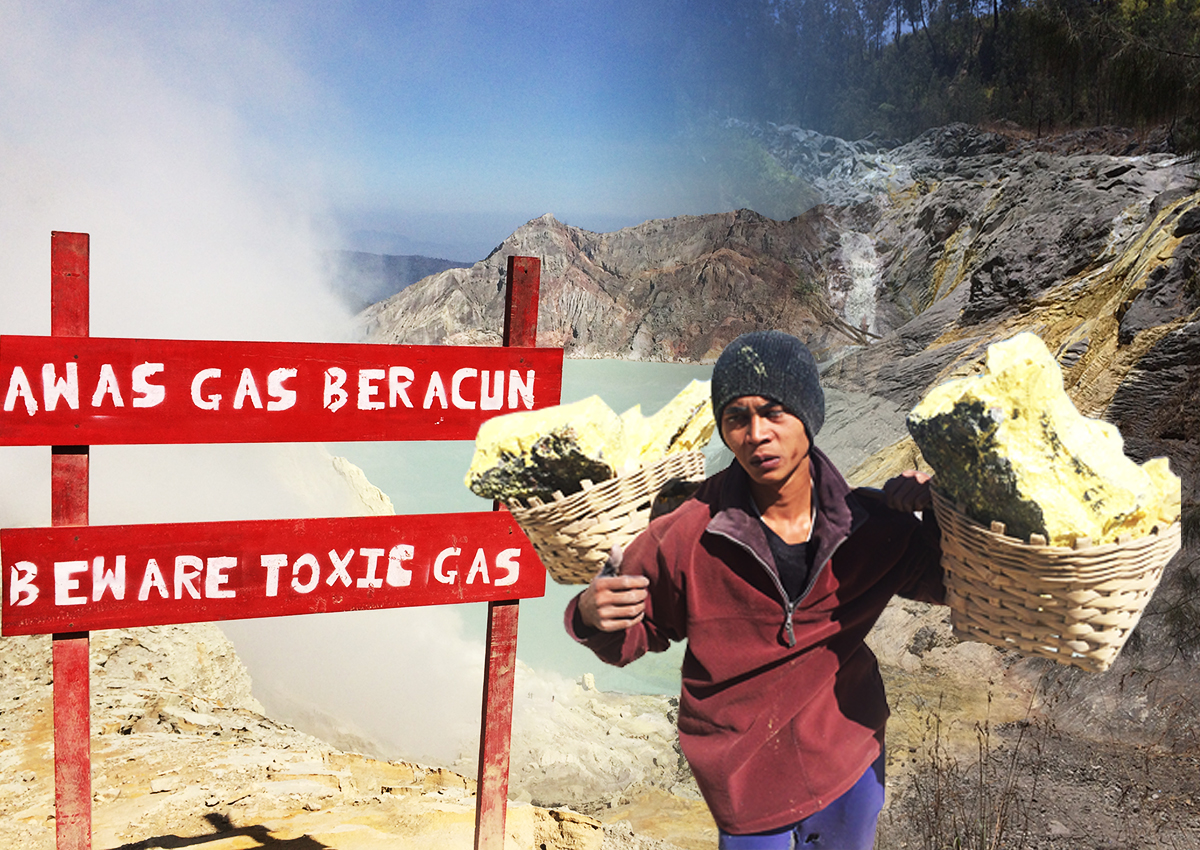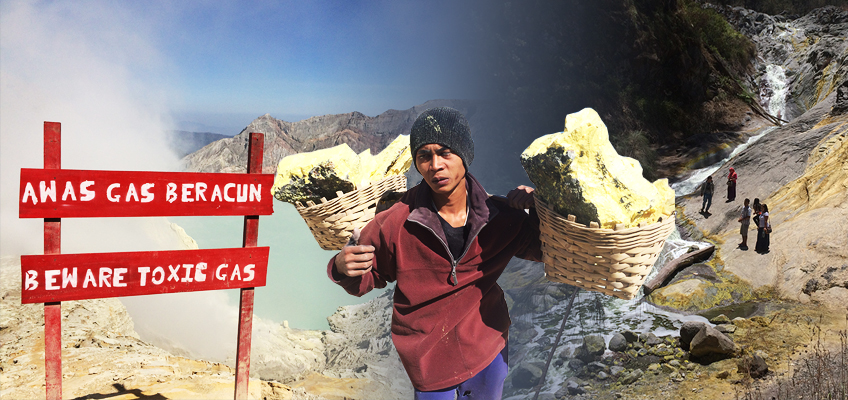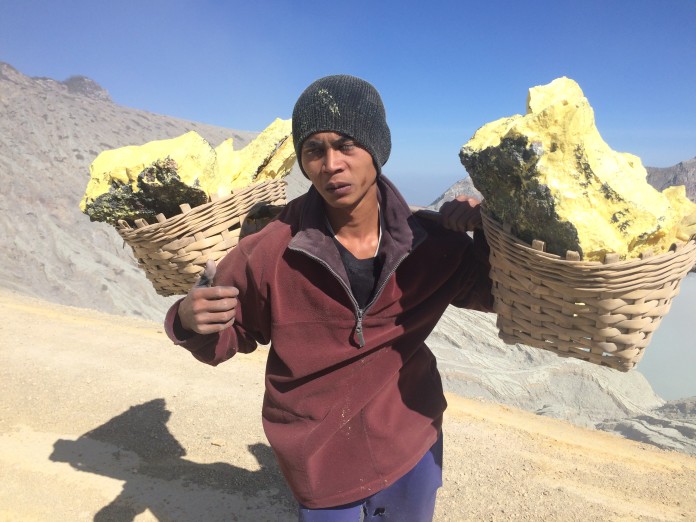It was all a blur.
My vision was clouded with sulphur mist blowing in my face but in the distance, I saw a young man, relatively short, small built and with tanned complexion, staggering towards me.
He was lugging two large dusty baskets balanced on a thin wooden plank.
Soon, I found out that his baskets contained sulphur pieces that he had mined when he approached me to buy some just as I was about to finish my climb on the glorious Kawah Ijen volcano, situated in Banyuwangi, a popular tourist destination on the eastern tip of Java, Indonesia.
Up close, I noticed that the man’s eyelashes were filled with yellow powder. He looked visibly tired from having to carry a heavy load at high altitude – at about 2,800 metres above sea level.
His skin was callous and his eyes were wrinkled.
He wore a mask, beanie, a long sleeve T-shirt and trousers, but his face was exposed to the hazardous fumes.
At that point as I was near the peak of the mountain, the smell of sulphur got to me – at times, it felt unbearable even though I had a mask on. It made me wonder how anyone could bear the smell at all.
As I went deeper in conversation with the miner, known only as Mr A., I found out that he was only 22 years old.
I was shocked. He looked at least 10 years older, in my opinion.
Although there are no clear studies to show that sulphur mining causes ageing, various health studies have found that inhaling sulphur fumes can cause serious respiratory problems. A report by Time magazine also said that the average life expectancy of a miner is about 50 years.
Just as I wondered how anything that Mr A. donned was enough to protect him from the sun and the hazardous gas, he told me that the T-shirt was enough to shield him.
Some of these miners even have shoulder lesions that grow as a result of carrying heavy baskets on their shoulders.
It was about 9am when Mr A. was making his way down the active volcano after his work shift for the morning had ended.
My tour guide, Mr Gatot, told me that these men can carry about 70-80kg of sulphur, which is probably a little more than the body weight of Mr A.
Mr Gatot also said that miners can earn between 1,000-1,050 Rupiah (S$0.10) for one kg of sulphur, depending on quality. As an estimate, a miner could typically earn about $7 a day if he mined 70kg of sulphur, and sold them at $0.10 per kg.
At Kawah Ijen, I learnt that it is quite common for the miners to try and sell their day’s reaping to tourists in order to make a quick buck – just like how Mr A. tried his luck with me.
Kawah Ijen is one of the biggest sulphur mines in Indonesia.
It is famous for its “blue fire”, which only occurs at night when sulphuric gases in the acidic crater lake are ignited at temperatures as high as 600 degree Celsius.
In the day, the active volcano is just as beautiful with a sea of yellow and blue in the crater.
At the peak, there are warning signs of toxic gas near the crater where all the dangerous sulphur mining activities take place.
There are other sulphur mines in other provinces, but they are mostly located on Java Island in regions such as West Java, Central Java, East Java, North Sumatra, North Sulawesi and Maluku.
According to another tour guide Mr Arie, there are about 300 to 400 sulphur miners in Indonesia today.
Every day, the miners begin their shifts after morning prayers, I was told. They mine twice a day, which means they only finish their shifts at about 1pm, or sometimes even at 3pm. If a colleague falls ill for the day, one of them will have to cover for him, working close to 12 hours a day.
So what do these sulphur miners actually risk their lives for?
After the pieces of sulphur are extracted from the crater, it goes to a local factory that exports the material to pharmaceutical companies, Mr Gatot explained.
Some of the uses of sulphur include fertilisers, cosmetics, paper, rubber and petroleum processing.
Sulphur mining is known to be one of the most dangerous jobs in the world, according to International Business Times. The miners have to hack chunks of sulphur off the rocks with steel bars and brave the extremely dangerous gases with minimal protection. After that, they load up the pieces and carry them for a distance to get to the weighing station where their harvest would be measured on an old weighing scale that few people still use today.
According to Time, more than 70 people have died in work-related accidents at Kawah Ijen in the past 40 years. Some of those deaths were reportedly caused by the sudden billowing of toxic gases from rock fissures.
Not quite the ideal job, considering the impending dangers.
After I took a photograph with Mr A., we went separate ways with tears rolling down my cheeks.
A myriad of emotions had overwhelmed me.
I thought also about another miner whom I had met halfway up the mountain. Mr Pote, 60, has been mining for the past 45 years. Although visibly old with a wrinkled face, he had on a megawatt smile. When asked about the long hours or dangers of his job, he proudly proclaimed that he is an “Ijen warrior”!
Despite the perils of the job, I understand that these miners love what they do. Even as I’m back at my desk writing this, their faces still remain clearly etched in my memory.
The biggest impression they left on me is their tenacity to fight through the struggles of their job and most of all, they remind me of how blessed my life is.
stephluo@sph.com.sg
(Photo credit: AsiaOne)
5 facts about sulphur:
1. Pure sulphur has no smell.
2. Sulphur is used as an ingredient to reduce the number of acne blemishes and to help control dandruff.
3. Sulphur exists in the human body.
4. Sulphur makes up three per cent of Earth’s mass.
5. Sulphur is also found in rain, which typically exists in the form of sulphur dioxide.





























































